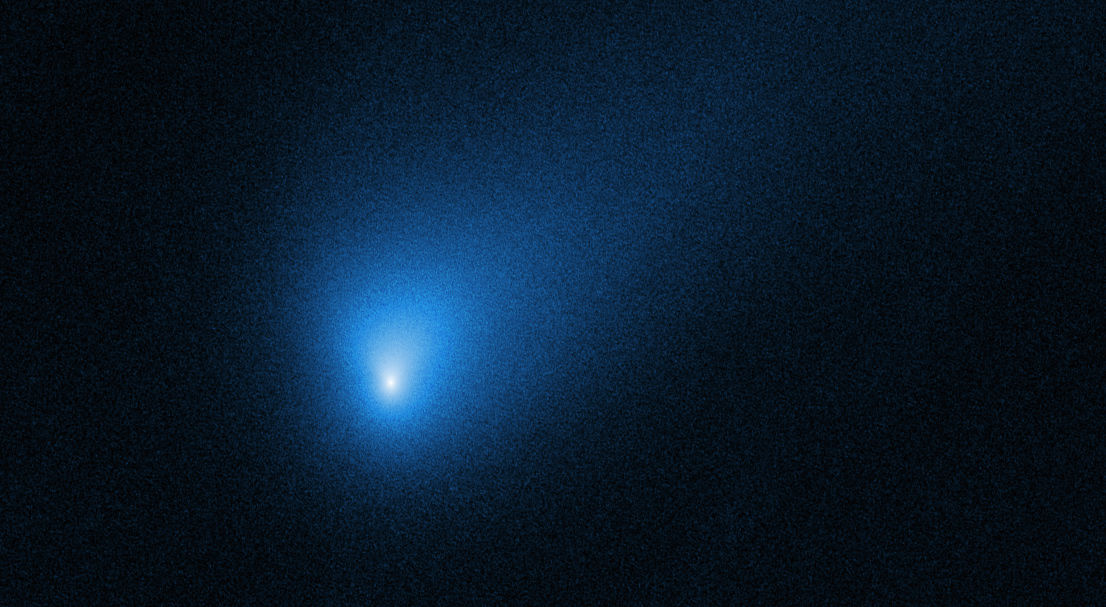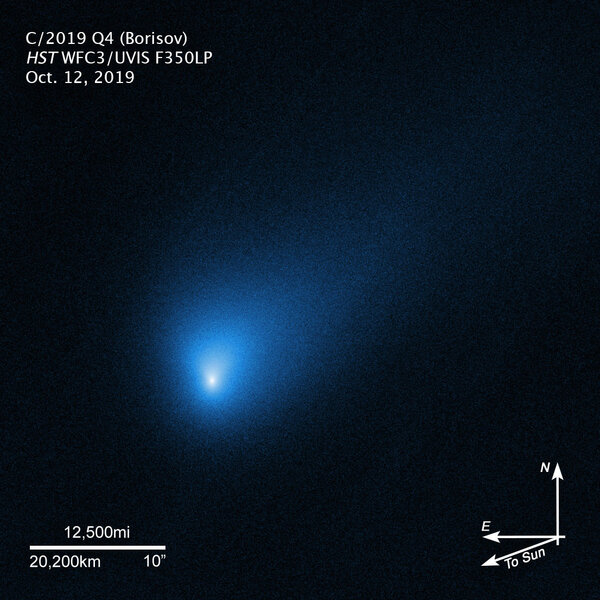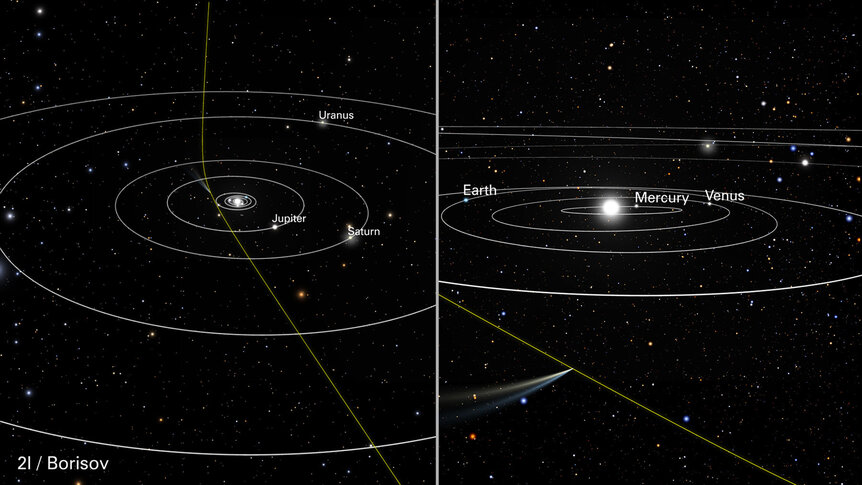Create a free profile to get unlimited access to exclusive videos, sweepstakes, and more!
Hubble observes an alien visitor: the comet 2I/Borisov

When the news was announced that a comet from another solar system — called 2I/Borisov — was passing through our own solar system, one of my first thoughts was I wonder how long it'll be before Hubble takes a look at it?
It turns out the answer is about six weeks. The comet was discovered on August 30, 2019, and it didn't take long before astronomers realized its orbit was really weird: It's clearly coming from interstellar space, an actual alien comet from another star! A flurry of observations were made, including some with some big 'scopes, and I knew folks would be working overtime to get Hubble observations of it as well.
The image takes a wee bit of explaining, but first, hey, here it is:
Coooool. There are a few things to note here, but right away I want to talk about the color. In the sense that it's not real. What I mean by that is that the comet isn't really blue! If anything, it's somewhat reddish, due to lots of dust around it reflecting sunlight.
The color shown here was chosen to add some flavor to the image, but the image itself doesn't have any color information in it! It was taken with a single filter, and you need multiple filters (for example, images taken using blue, green, and red filters) to get an actual idea of the real color. When you take an image with a single filter, you can't tell the difference between a red photon and a blue one. In this case, they used a very wide bandpass filter (if you want the tech stuff, it's the F350LP filter on the WF3 camera), meaning it sees color from across the visible spectrum, from blue to red, all at the same time.
The blue was added to the image, so don't mistake this meaning the comet itself is blue.
OK, having said that, there's some interesting stuff to be seen in the image. The nucleus (the solid chunk of rock, gravel, dust, and ice) is compact, which isn't too surprising. Various methods have been used to figure out how big it is, and it's likely to be very roughly 10 kilometers or so across (though it may be a lot smaller; these size determination methods are difficult). That's far too small to be seen in this Hubble image, since the comet itself was 420 million kilometers away when this image was taken! That's nearly three times the distance of the Earth to the Sun, so something as small as a city is too small to resolve.
The coma is the fuzzy glow around the comet caused by material leaving the nucleus and surrounding it. When a comet nears the Sun, the warmth from sunlight turns the ice directly into gas, which then flows away. But this also has rocks and dust embedded in it, so the material around the nucleus is both gassy and dusty.
In general, dust reacts to the pressure of sunlight, and flows slowly away, forming the dust tail. Gas can be ionized (losing an electron or three) by ultraviolet sunlight, and that ionized gas (technically, a plasma) then reacts more strongly to the solar wind, which pushes it straight away from the Sun at high speed. So you can get two tails, which is common. Here it looks to me that we're only seeing one moving to the upper right. The direction to the Sun is to the lower left, so that tail may be the gas one. The coma itself seems a bit stretched toward the top, so that may be part of the dust tail. Mind you, I'm guessing here. Hopefully more images, especially ones taken using multiple filters, will help here.
To me, what's still the weirdest thing about this comet is how totally unweird it is. This could be a Hubble image of any old comet, one from our own solar system — certainly there's nothing in this image to sound any alarm bells over its alienness. I wrote about this a few weeks ago, too: Ground-based telescopes looking at the comet have taken spectra, which allow the chemical composition to be determined, and they saw nothing unusual about it. For example, it's emitting CN molecules (a carbon and nitrogen atom bound together, possibly starting out life as hydrogen cyanide, HCN, which is split by sunlight), a very common molecule in comets. Heck, it'd be more weird if CN weren't seen. C2, a molecule consisting of two carbon atoms linked together, has been found as well. That's also common (and why many comets appear to be green in color).
Even looking at the activity in general it appears normal; looking at the production of dust now and then backtracking, it appears that it became active when it was 650 million km from the Sun, which is pretty typical.
This is in stark contrast to 'Oumuamua, the first interstellar visitor to our solar system ever seen. There was no direct evidence of activity at all — no coma, no tail, nothing — which really is pretty weird (as it moved around the Sun it appeared to accelerate slightly, indicating that perhaps it was outgassing a bit, giving it a mild rocket boost, but no direct evidence of that was seen). Why are these two objects so very different? That's something astronomers would love to know.
So in the end, or at least so far, the most surprising thing about this comet is how unsurprising it is. Now mind you, there could be some big differences in its chemical composition that we can't detect. For example, elements have isotopes, which are like different flavors of that element. Oxygen has 8 protons in its nucleus, but different isotopes can have 8, 9, or even 10 neutrons in their nuclei. When you look at objects from the inner versus outer solar system, they have different ratios of these isotopes in them. But that's a difficult observation to make, and I doubt it can be done on this comet.
On the other hand, going to a comet like this and analyzing it up close, in situ, is a different story. That's why the European Space Agency is planning on a mission called Comet Interceptor, which will have the ability to wait for such an unusual visitor to come in and then match orbits with it, so it can take a look-see from extremely close in. That will really be something!
But until then we'll have to rely on observatories here on Earth — or above it — to observe this comet. Hubble is planning on taking more observations between now and January, including, I certainly hope, getting spectra of it to see what it's made of.
Even if this comet turns out to be completely ordinary, that's quite extraordinary, because even that tells us that conditions around other stars are similar to those here, and that in turn tells us even more strongly that the basic ingredients of planets, stars, and even life are available everywhere.
Maybe that's the big lesson of this comet; an oxymoron: Getting solid evidence of our mundanity is actually pretty exciting.




























